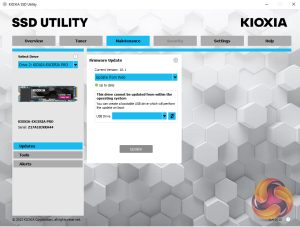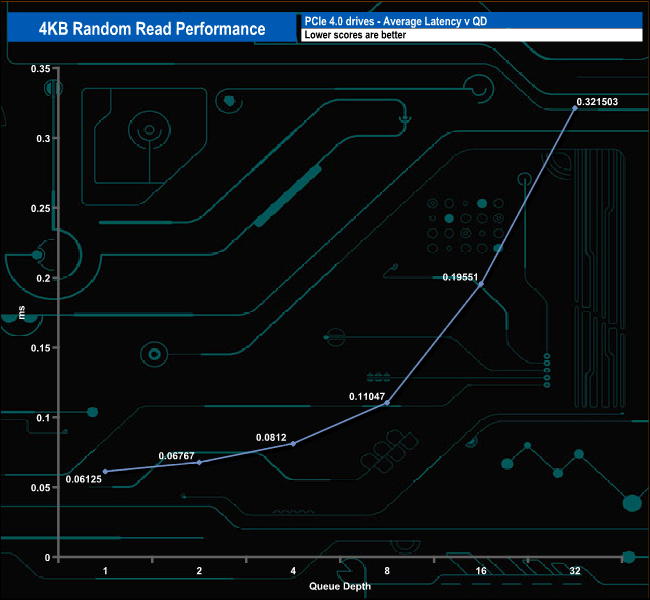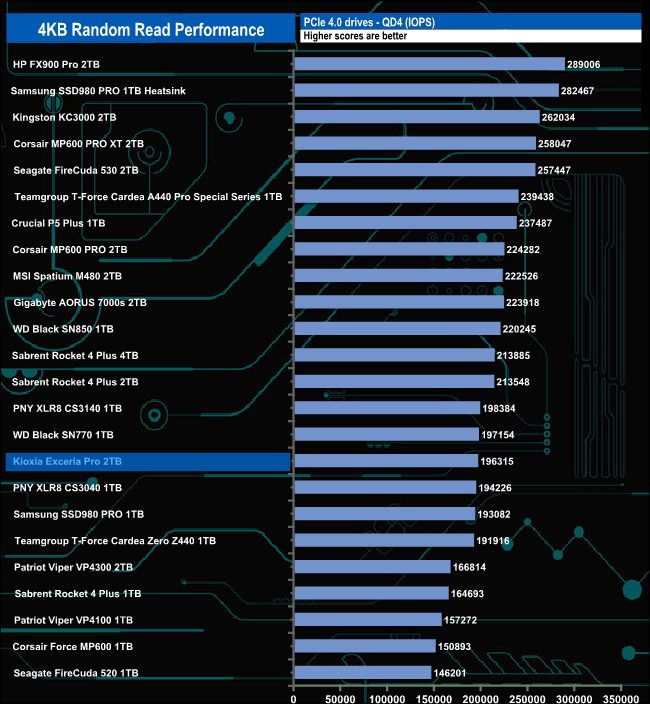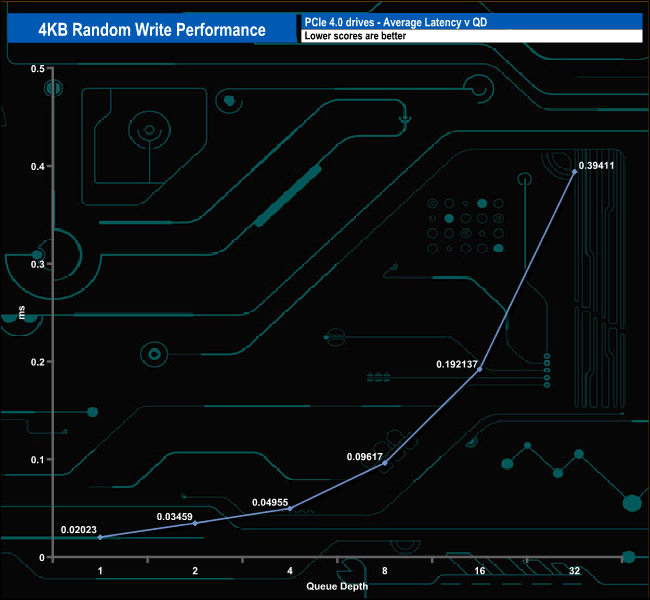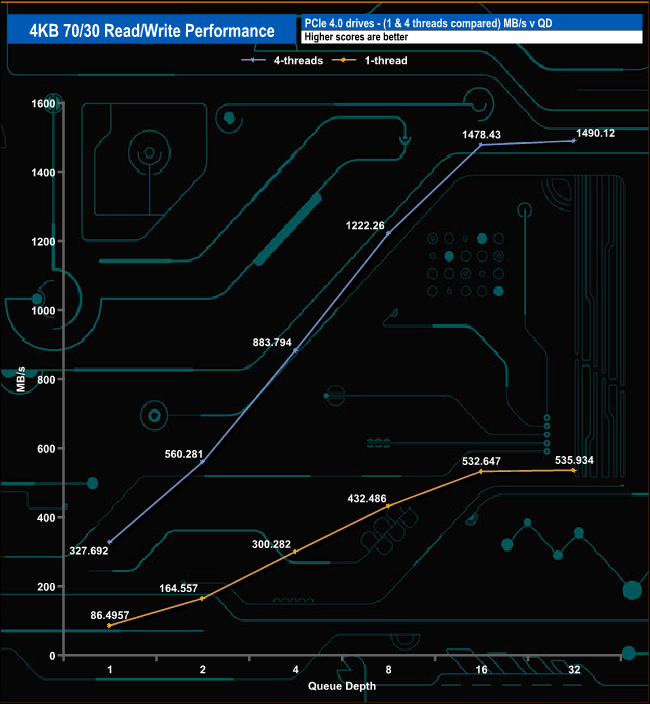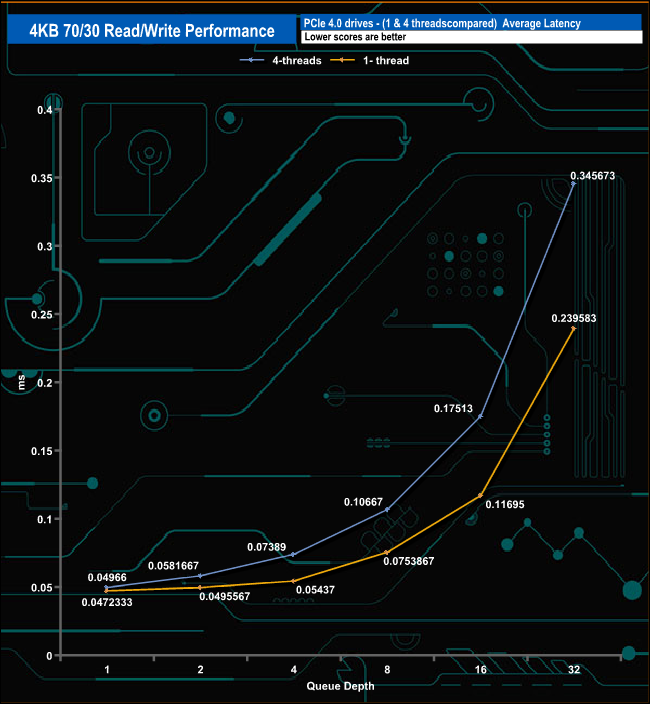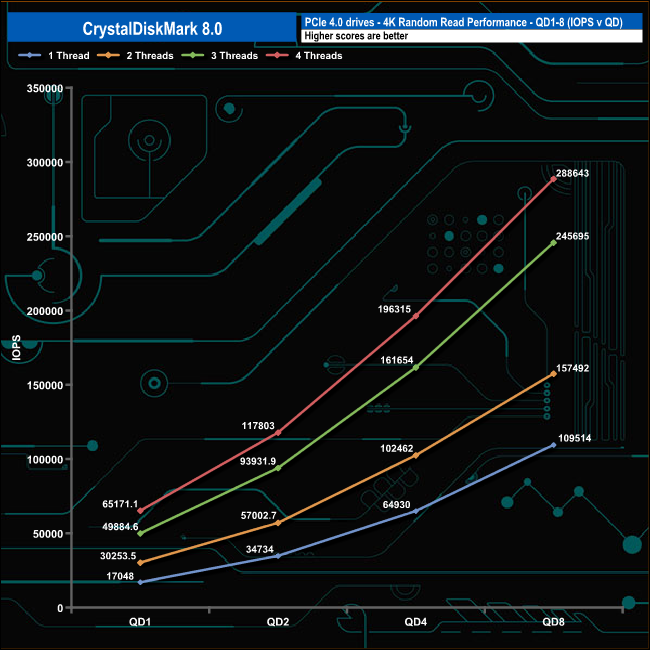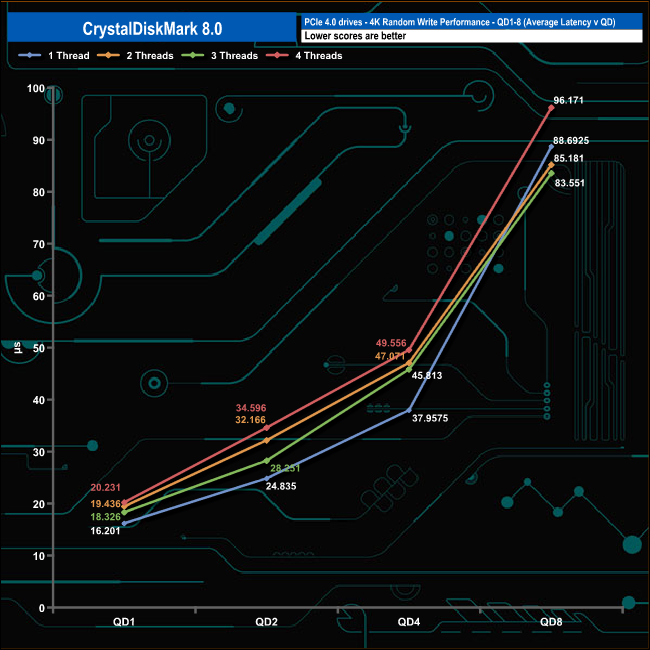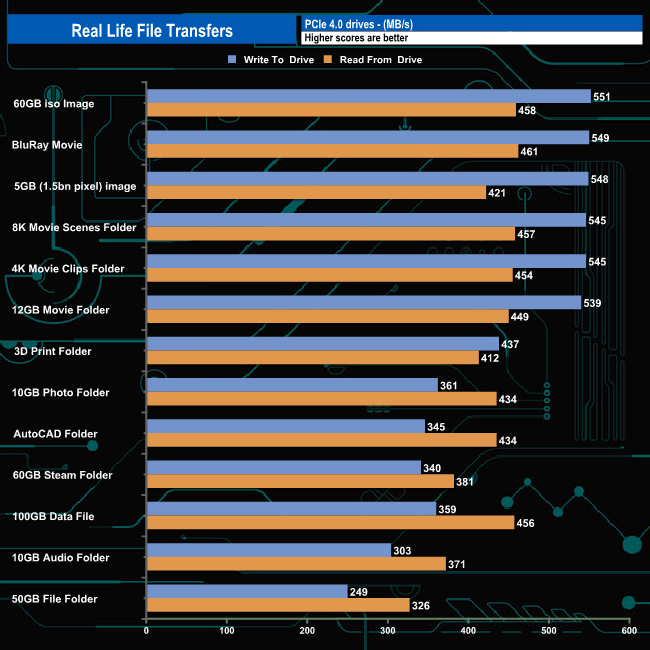
The Exceria Pro is Kioxia's debut in the highly competitive PCIe Gen4 market. Sitting under Kioxia's Personal Product banner, the Exceria Pro uses the company's own 112-layer TLC NAND together with an eight-channel controller. With the 2TB model priced at just over £370, we put it through its paces and find out if it is worth buying.

The Exceria Pro model line-up comprises just two capacities; 1TB and the flagship 2TB drive we are reviewing here. The 2TB drive uses four packages of Kioxia's own 5th generation 112-layer BiCS5 TLC NAND in combination with a Kioxia branded controller and a 2GB cache IC.
Kioxia quotes Sequential read/write performance for the two drives as up to 7,300MB/s and up to 6,400MB/s respectively. The 1TB drive is rated as up to 1M IOPS for 4K random reads while the 2TB drive is slower at up to 800,000 IOPS. Random write performance is quoted as up to 1.1M IOPS for the 1TB drive with the 2TB drive faster at up to 1.3M IOPS.
Kioxia rate the TBW endurance for the drives at 400TB for the 1TB drive and 800TB for the 2TB model and backs the range with a 5-year warranty.
Physical Specifications:
- Usable Capacities: 2TB.
- NAND Components: Kioxia BiCS5 112-layer TLC NAND
- NAND Controller: Kioxia.
- Cache: 2GB.
- Interface: PCIe Gen4 x4 (NVMe 1.4).
- Form Factor: M.2 2280.
- Dimensions: 80.15 x 22.15 x 2.23mm.
- Drive Weight: 8.0g.
Firmware Version: EIFA10.1

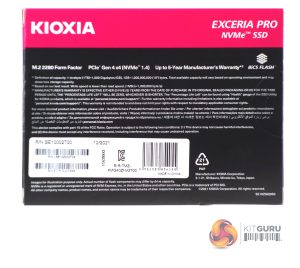
The Exceria NVMe comes in a compact box with an image of the drive on the front, along with a sticker displaying the capacity of the drive and the drive's Sequential read speed (up to 7,300MB/s). The rear of the box has a description of the drive’s form factor, a small logo representing it uses BiCS Flash, PCIe Gen 4 x4 interface and has a 5-year warranty.

Built on a single-sided M.2 2280 format, the 2TB drive uses four 512GB packages of Kioxia's own BiCS5 112-layer 3D TLC NAND along with a Kioxia branded controller (TC58NC1210GSE) and a 2GB SK hynix DDR4-3200 cache chip.
The SSD Utility lets you check on the drive’s capacity, how it’s being used and how much life is left in the SSD. There’s a tuning section with an integrated benchmark so you can see how the drive is running. It also allows for easy implementation of firmware updates and there is a comprehensive help section as well.
For testing, the drives are all wiped and reset to factory settings by HDDerase V4. We try to use free or easily available programs and some real-world testing so you can compare our findings against your own system.
This is a good way to measure potential upgrade benefits.
Main system:
AMD Ryzen 5 3600X, 16GB DDR4-2400, Sapphire R9 390 Nitro and an MSI MPG X570 Gaming Edge Wifi motherboard.
Other drives
Corsair MP600 PRO 2TB
Corsair Force MP600 1TB
Corsair MP600 PRO XT 2TB
Crucial P5 Plus 1TB
Gigabyte AORUS 7000e 2TB
HP FX900 Pro 2TB
Kingston KC3000 2TB
MSI Spatium M480 2TB
Patriot Viper VP4300 2TB
Patriot Viper VPN4100 1TB
PNY XLR8 CS3040 1TB
PNY XLR8 CS3140 1TB
Sabrent Rocket 4 Plus 1TB
Sabrent Rocket 4 Plus 2TB
Sabrent Rocket 4 Plus 4TB
Samsung SSD980 PRO 1TB
Samsung SSD980 PRO Heatsink 1TB
Seagate FireCuda 520 1TB
Seagate FireCuda 530 2TB
Teamgroup T-Force Cardea Zero Z440 1TB
Teamgroup T-Force Cardea A440 Pro Special Series 1TB
WD Black SN770 1TB
WD Black SN850 1TB
Software:
Atto Disk Benchmark 4.
CrystalMark 7.0.0.
AS SSD 2.0.
IOMeter.
Futuremark PC Mark 10.
All our results were achieved by running each test five times with every configuration this ensures that any glitches are removed from the results. Trim is confirmed as running by typing fsutil behavior query disabledeletenotify into the command line. A response of disabledeletenotify =0 confirms TRIM is active.
CrystalDiskMark is a useful benchmark to measure theoretical performance levels of hard drives and SSDs. We are using v8.0.
Using the default CrystalBenchMark 8 4K QD1 T-1 benchmark the read result of 69.46MB/s sees the Exceria Pro sitting in the lower mid part of our results chart. The write result of 246.82MB/s is much better than the other drives with read results in the 60MB/s range.
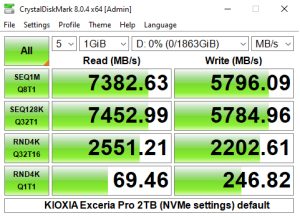

Looking at the default benchmark result screens we could confirm the official Sequential maximum read figure of 7,300MB/s with a test result of 7,382MB/s (7,417MB/s using compressed data). Tested Sequential write performance came up a little short of the official 6,400MB/s at 5,796MB/s (5,845MB/s using compressed data).
That tested read score of 7,382MB/s puts the drive into the top 5 in our results chart although just like the Teamgroup T-Force drive just above it, the write test results aren't anywhere near the top two drives in the table.
Switching over to the CrystalDiskMark 8 Peak Performance profile we could once again confirm the official Sequential read figure with a test result of 7,383B/s. However, write performance at 5,793MB/s again came up short of the official maximum figure.
The 4K test results had both reads and writes far below the official figures. The 2TB Exceria Pro is rated up to 800K IOPS for reads and 1.3M IOPS for writes. The best read result we saw in the default CrystalDiskMark Peak Performance test was 646,906 IOPS for reads and 530,872 IOPS for writes.
Using the Real World profile sees the drive sitting just inside the top 10 drives with a Sequential read result of 4,031MB/s while write performance is much better at 5,570MB/s.
The ATTO Disk Benchmark performance measurement tool is compatible with Microsoft Windows. Measure your storage systems' performance with various transfer sizes and test lengths for reads and writes. Several options are available to customize your performance measurement including queue depth, overlapped I/O and even a comparison mode with the option to run continuously. Use ATTO Disk Benchmark to test any manufacturer's RAID controllers, storage controllers, host adapters, hard drives and SSD drives and notice that ATTO products will consistently provide the highest level of performance to your storage.
We are using version 4.0 for our NVMe disk tests.
In the ATTO benchmark both test results for the Exceria Pro, 6,860MB/s for reads and 5,780MB/s for writes are a fair bit short of the official maximum read/write figures of 7,300MB/s and 6,400MB/s respectively.
AS SSD is a great free tool designed just for benching Solid State Drives. It performs an array of sequential read and write tests, as well as random read and write tests with sequential access times over a portion of the drive. AS SSD includes a sub suite of benchmarks with various file pattern algorithms but this is difficult in trying to judge accurate performance figures.
The drive's read and write scores of 2,666 and 2,877, respectively, see the Exceria Pro sitting in mid table in the AS-SSD benchmark run.
We used CrystalDiskMark 8‘s custom settings to test the Sequential read and write performance of the drive through a range of queue depths. The setup for the tests is listed below.
128KB Sequential Read / Write.
Transfer Request Size: 128KB, Thread(s): 1, Outstanding I/O: 1-32.
In the 128KB Sequential read and write tests, the drives read performance climbs smoothly as the queue depth deepens, reaching 7,425.97MB/s at the end of the test run at QD32, a figure that confirms the official maximum speed of 7,300MB/s.
When it comes to write performance the drive rises rapidly in performance from QD1- QD2 then begins to plateau out with a peak of 5,853.30MB/s at QD4 before dropping back slightly to end the test run at 5,845.10 MB/s, quite a bit short of the official 6,400MB/s.
128KB Sequential Read compared.
The 2TB Kioxia Exceria Pro is the slowest Gen 4 drive we've seen to date at QD1 but by QD2 it has closed the gap to its nearest competitor and continues to climb as the queue depth deepens until the end of the test run at QD32 by which time the drive is the fourth fastest consumer Gen 4 drive we've seen to date.
128KB Sequential Write compared.
When it comes to Sequential writes, the Exceria Pro sits in mid-table throughout the tested queue depths.
We used CrystalDiskMark 8‘s custom settings to test the 4K random read performance of the drive through a range of queue depths. The setup for the tests is listed below.
Transfer Request Size: 4KB, Outstanding I/O: 1-32.
Kioxia rate the 4K random read performance of the 2TB Exceria Pro as up to 800,000 IOPS. Using our 4-threaded 4K random testing, the best we saw was 391,308 IOPS (QD32). We did a quick test at QD32 using eight threads which gave a result of 573,040 IOPS.
4K Random Read v QD performance compared.
In relation to the drives around it, the Exceria Pro's slowest performance comes at QD1 where it sits in the bottom half of our results chart and it makes slow progress up the chart in QDs 2 and 4. However, at QD32 the drive's performance sees it jump to a mid-table position.
We used CrystalDiskMark 8‘s custom settings to test the 4K random write performance of the drive through a range of queue depths. The setup for the tests is listed below.
Transfer Request Size: 4KB, Outstanding I/O: 1-32.
In the random write test, the best test result we saw from the Exceria Pro was 324,741 IOPS (QD16), which is nowhere near the official maximum of 1.3M IOPS. We did a quick test of the drive using eight threads at QD32 and got a test result of 417,058 IOPS, still nowhere close to the official figure.
4K Random Write v QD performance compared.
The drive performs reasonably well at QD1, sitting just outside the top five drives we've tested to date but at QD2 the drive plummets down the table. QD4 sees the drive's performance recover enough to place in the top ten but at QD32 it has slid down the table again, but nowhere near as dramatically as the QD2 drop.
We used CrystalDiskMark 8’s custom settings to test the 4K 70/30 mixed read/write performance of the drive through a range of queue depths using a single thread and four threads.
The Kioxia Exceria Pro has no problem dealing with our 70/30 read/write tests either with a single thread or four threads. With a single thread, the drive climbs from 21,117 IOPS (86.49MB/s) at QD1 up to 130,843 IOPS (535.93MB/s) at QD32. With four threads the drive goes from 80,002 IOPS (327.69MB/s) at QD1 up to 363,800 IOPS (1,490.12MB/s) at QD32.
With both thread tests, the rate of performance increase slows from QD16 onwards.
We used CrystalDiskMark 8 to test the random performance of the drive at lower queue depths (QD1 – QD8 where most of the everyday workloads occur) using 1 to 4 threads.
4K Random Read

In our lower queue depth, 4K random read tests, the performance increases steadily as the queue depth deepens for each thread. At QD1 the performance ranged from a low point of 17,048 IOPS (69.82MB/s) for a single thread up to 65,171 IOPS (266.94MB/s) for four threads. At QD8 a single thread produced 109,514 IOPS (448MB/s), two threads 157,492 IOPS (645MB/s), three threads 245,569 IOPs (1,006MB/s) and finally with four threads, 288,643 IOPS (1,182MB/s).
4K Random Write
In the 4K write performance test it's only when using three threads that the drive's performance continues to climb through the tested queue depths. The three other tested threads see the performance begin to plateau out. With a single thread, it's at QD2, with two and four threads it's at QD4.
In our read throughput test the Exceria Pro peaked at the end of the test run at 5,520MB/s, so way off the official maximum for the drive of 7,300MB/s.
Although some distance shy of the official maximum of 7,300MB/s, the test result of 5,520MB/s was good enough the place the Exceria Pro into the top 5 of our results chart.
In the write throughput test the drive produced a best of 6,084MB/s, again short of the official maximum figure (6,400MB/s) but a lot closer to the official figure than the read throughout result.

That result of 6,084MB/s sees the Exceria Pro slip into sixth place on our results chart.
The PCMark 10 Full System Drive Benchmark uses a wide-ranging set of real-world traces from popular applications and common tasks to fully test the performance of the fastest modern drives. The benchmark is designed to measure the performance of fast system drives using the SATA bus at the low end and devices connected via PCI Express at the high end.
The goal of the benchmark is to show meaningful real-world performance differences between fast storage technologies such as SATA, NVMe, and Intel’s Optane. The Full System Drive Benchmark uses 23 traces, running 3 passes with each trace. It typically takes an hour to run.
Traces used:
Booting Windows 10.
Adobe Acrobat – starting the application until usable.
Adobe Illustrator – starting the application until usable Adobe Premiere Pro – starting the application until usable.
Adobe Photoshop – starting the application until usable.
Battlefield V – starting the game until the main menu.
Call of Duty Black Ops 4 – starting the game until the main menu.
Overwatch – starting the game until main menu.
Using Adobe After Effects.
Using Microsoft Excel.
Using Adobe Illustrator.
Using Adobe InDesign.
Using Microsoft PowerPoint.
Using Adobe Photoshop (heavy use).
Using Adobe Photoshop (light use).
cp1 Copying 4 ISO image files, 20 GB in total, from a secondary drive to the target drive (write test).
cp2 Making a copy of the ISO files (read-write test).
cp3 Copying the ISO to a secondary drive (read test).
cps1Copying 339 JPEG files, 2.37 GB in total, to the target drive (write test).
cps2 Making a copy of the JPEG files (read-write test).
cps3 Copying the JPEG files to another drive (read test).
The best result from the Kioxia Exceria Pro in PCMark10’s Full System Drive Benchmark Adobe test traces was the 929MB/s for the Heavy Use Adobe Photoshop trace while the best result in the gaming test traces was the 688MB/s from Call Of Duty: Black Ops 4 trace. The file transfer tests also produced a good cp1 (write test) figure of 3,619MB/s backed up by the 2,230MB/s for the cp3 (read test) and 2,634MB/s for the cp2 read/write test traces.
The overall bandwidth figure of 406.71MB/s sees the drive positioned in the lower mid half of the table.
The 3DMark Storage Benchmark uses traces recorded from popular games and gaming-related activities to measure real-world gaming performance.
Traces used –
Battlefield V
Loading Battlefield™ V from launch to the main menu.
Call of Duty Black Ops 4
Loading Call of Duty®: Black Ops 4 from launch to the main menu.
Overwatch
Loading Overwatch® from launch to the main menu.
Game Move
Copying the Steam folder for Counter-Strike®: Global Offensive from an external SSD to the system drive.
Game Recording
Recording a 1080p gameplay video at 60 FPS with OBS (Open Broadcaster Software) while playing Overwatch®.
Installing Game
Installing The Outer Worlds® from the Epic Games Launcher.
Game Saving
Saving progress in The Outer Worlds game.
In 3DMark’s Storage Test, the FX900 Pro had an average bandwidth figure of 625MB/s for the three-game load tests (Battlefield V, Call of Duty: Black Ops 4 and Overwatch) with an average access time of 87µs for the same three games.
The overall average bandwidth figure for the complete test run was 534.79MB/s which puts the drive just outside the top five drives we've tested to date.
For the long-term performance stability test, we set the drive up to run a 20-minute 4K random test with a 30% write, 70% read split, at a Queue Depth of 256 over the entire disk. The 2TB Exceria Pro averaged 121,185 IOPS for the test with a performance stability of an excellent 91%. It did seem, however, that there were some signs of thermal throttling towards the end of the test run.
We took note of the drive’s temperature during some of our benchmarking runs. The Kioxia Exceria Pro doesn't come with any form of a physical heat sink and did run very hot during some of our more extreme benchmark tests. It ran hottest when being pushed extremely hard during repeated runs of the CrystalDiskMark 8 test where the drive got to 72° C, rather too close to the 85° C drive maximum temperature for comfort. During the Performance Stability test, it peaked at 70° C. During these repeated tests there were signs that the drive was thermal throttling to some degree.
To test the real-life performance of a drive we use a mix of folder/file types and by using the FastCopy utility (which gives a time as well as MB/s result) we record the performance of a drive reading from & writing to a 256GB Samsung SSD850 PRO.
We use the following folder/file types:
- 100GB data file.
- 60GB iso image.
- 60GB Steam folder – 29,521 files.
- 50GB File folder – 28,523 files.
- 21GB 8K Movie demos.
- 12GB Movie folder – 24 files (mix of Blu-ray and 4K files).
- 11GB 4K Raw Movie Clips (8 MP4V files).
- 10GB Photo folder – 621 files (mix of png, raw and jpeg images).
- 10GB Audio folder – 1,483 files (mix of mp3 and .flac files).
- 5GB (1.5bn pixel) photo.
- Blu-ray movie.
The Exceria Pro was a solid performer when it came to our real-life file transfers particularly when dealing with the larger file size transfers, averaging 546MB/s for writes and 450MB/s for reads when dealing with these file types.
To get a measure of how much faster PCIe NVMe drives are than standard SATA SSDs we use the same files but transfer to and from a 2TB Kioxia Exceria Plus drive:
Switching over to NVMe to NVMe file transfers saw the bandwidths rocket upwards and transfer times drop dramatically. Five of the write speeds topped 3GB/s, the fastest being the 3,100MB/s for the 60GB iso image while nine of the read transfers topped 2GB/s, the fastest being the 8K movie scenes folder at 2,794MB/s
The Exceria Pro is Kioxia‘s first PCIe Gen 4 drive aimed at the consumer market segment. The Exceria Pro family is made up of just two capacities, 1TB and the flagship 2TB drive. The drive uses a combination of Kioxia's own BiCS5 112-layer 3D TLC NAND along with a Kioxia branded controller. Kioxia has kept details about the controller very close to their chest but an educated guess is that it's probably a re-branded Phison PS5018-E18.
The official maximum Sequential read/write performance figures for the 2TB Exceria Pro are up to 7,300MB/s and 6,400MB/s respectively. Using the ATTO benchmark we couldn’t quite hit either of these figures (6,860MB/s reads, 5,780MB/s write), but we could confirm the official read figure with the CrystalDiskMark benchmark. The best test read figure we saw was 7,417.26MB/s using CrystalDiskMark 8 (NVMe settings, default profile, compressible data). The best write result of 5,862MB/s, which is shy of the official maximum, came when the drive was tested with CrystalDiskMark's Peak Performance profile using compressible data.
When it came to 4K performance, we couldn't get close to the official maximum figures with our 4-threaded testing. The 2TB version of the Exceria Pro is rated as up to 800,000 IOPS with writes up to 1.3M IOPS. The best we saw from the drive was when tested with CrystalDisMark 8's Peak Performance Profile (0 fill), which produced a peak read figure of 646,906 IOPS while writes peaked at 540,875 IOPS.
The drive doesn't come with any form of heatsink, not even something as simple as a layer of copper under the label – which is a bit of an odd choice with a Gen 4 drive as they do get quite toasty. Indeed, during some of our more stressful testing, we did see some thermal throttling occurring but rather than seeing the performance drop off a cliff, it was more of a managed gradual reduction. Adding a 3rd party heatsink solution or using a motherboard's drive cooling solution should prevent this from happening.
We found the 2TB version of the Kioxia Exceria Pro for £374.33 (inc VAT) on ebuyer.com HERE.
Pros
- BiCS5 TLC NAND.
- Overall Performance.
- Endurance.
Cons
- Couldn't get close to the official 4K maximums under testing.
- Really needs some form of heatsink.
- Pricey.
KitGuru says: Kioxia's first consumer Gen4 SSD is very good. But, and it's pretty important but… it does run hot and given the price of it, the decision not to have any form of heatsink is an odd one, especially as we saw thermal throttling in some of our testing. As it stands the drive really needs the be installed under a motherboard cooling solution or a 3rd party heatsink to keep it happy.
 KitGuru KitGuru.net – Tech News | Hardware News | Hardware Reviews | IOS | Mobile | Gaming | Graphics Cards
KitGuru KitGuru.net – Tech News | Hardware News | Hardware Reviews | IOS | Mobile | Gaming | Graphics Cards






